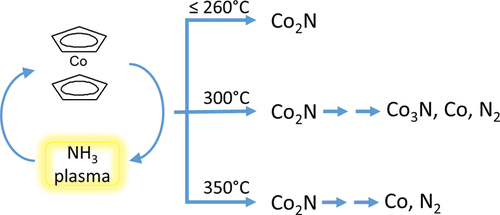当前位置:
X-MOL 学术
›
J. Phys. Chem. C
›
论文详情
Our official English website, www.x-mol.net, welcomes your
feedback! (Note: you will need to create a separate account there.)
Plasma-Enhanced Atomic Layer Deposition of Cobalt and Cobalt Nitride: What Controls the Incorporation of Nitrogen?
The Journal of Physical Chemistry C ( IF 3.3 ) Pub Date : 2020-09-02 , DOI: 10.1021/acs.jpcc.0c04223 Gerben van Straaten 1 , Rick Deckers 1 , Martijn F. J. Vos 1 , Wilhelmus M. M. Kessels 1 , Mariadriana Creatore 1
The Journal of Physical Chemistry C ( IF 3.3 ) Pub Date : 2020-09-02 , DOI: 10.1021/acs.jpcc.0c04223 Gerben van Straaten 1 , Rick Deckers 1 , Martijn F. J. Vos 1 , Wilhelmus M. M. Kessels 1 , Mariadriana Creatore 1
Affiliation

|
The present study covers the processes that govern the incorporation of nitrogen in the film during atomic layer deposition (ALD) of cobalt and cobalt nitride prepared from cobaltocene (CoCp2) and NH3 plasma. It is demonstrated that nitrogen incorporation is strongly temperature-dependent; at temperatures of 260 °C and below, the deposited films consist primarily of Co2N, whereas increasing the temperature to 300 °C leads to a mixture of Co3N and Co, and at 350 °C, nominally pure Co is obtained. The sample temperature clearly has a very strong effect on the composition of the deposited film, and in order to understand this temperature dependence, the thermal stability of the CoNx species formed during the interaction between a sample consisting of pure Co and an NH3 plasma is analyzed. X-ray photoemission spectroscopy depth profiling reveals that this plasma treatment converts the top 4 nm of the Co film into CoNx. Temperature-programmed desorption experiments show that this nitride layer starts to decompose at a temperature of approximately 290 °C, which eventually leads to complete removal of all nitrogen from the film. Based on this, a reaction scheme for ALD of Co is proposed; the interaction between the NH3 plasma and the adsorbed CoCp2-derived species leads to the formation of cobalt nitride. At temperatures below 290 °C, the resulting film primarily consists of Co2N, whereas at 300 °C, partial decomposition takes place, resulting in the formation of a mixture of Co3N and pure Co. At 350 °C, decomposition is effectively complete, leading to pure Co with nitrogen contents below 4 at %. Finally, it is argued that the aforementioned mechanism could potentially play a role in plasma-enhanced ALD of other elements that form metastable nitrides such as Ni, Cu, Re, and Ru.
中文翻译:

钴和氮化钴的等离子体增强原子层沉积:什么控制氮的掺入?
本研究涵盖了控制钴和由钴茂(CoCp 2)和NH 3等离子体制备的氮化钴的原子层沉积(ALD)过程中膜中氮掺入的过程。结果表明,氮的掺入与温度密切相关。在260°C和更低的温度下,沉积的薄膜主要由Co 2 N组成,而将温度提高到300°C会导致Co 3 N和Co的混合物,并在350°C时获得名义上纯的Co。样品温度显然对沉积膜的组成有非常强的影响,并且为了理解这种温度依赖性,CoN x的热稳定性分析了由纯Co和NH 3等离子体组成的样品之间的相互作用过程中形成的杂质。X射线光电子能谱深度剖析表明,这种等离子体处理将Co膜的顶部4 nm转换为CoN x。程序升温解吸实验表明,该氮化物层在大约290°C的温度下开始分解,最终导致薄膜中所有氮的完全去除。在此基础上,提出了钴的ALD反应方案。NH 3等离子体与吸附的CoCp 2衍生的物种之间的相互作用导致形成氮化钴。在低于290°C的温度下,所得薄膜主要由Co 2组成N,而在300°C时会发生部分分解,从而形成Co 3 N和纯Co的混合物。在350°C时,分解有效完成,导致纯Co的氮含量低于4 at%。最后,有人认为上述机制可能在其他形成亚稳态氮化物(如Ni,Cu,Re和Ru)的元素的等离子体增强ALD中发挥作用。
更新日期:2020-10-08
中文翻译:

钴和氮化钴的等离子体增强原子层沉积:什么控制氮的掺入?
本研究涵盖了控制钴和由钴茂(CoCp 2)和NH 3等离子体制备的氮化钴的原子层沉积(ALD)过程中膜中氮掺入的过程。结果表明,氮的掺入与温度密切相关。在260°C和更低的温度下,沉积的薄膜主要由Co 2 N组成,而将温度提高到300°C会导致Co 3 N和Co的混合物,并在350°C时获得名义上纯的Co。样品温度显然对沉积膜的组成有非常强的影响,并且为了理解这种温度依赖性,CoN x的热稳定性分析了由纯Co和NH 3等离子体组成的样品之间的相互作用过程中形成的杂质。X射线光电子能谱深度剖析表明,这种等离子体处理将Co膜的顶部4 nm转换为CoN x。程序升温解吸实验表明,该氮化物层在大约290°C的温度下开始分解,最终导致薄膜中所有氮的完全去除。在此基础上,提出了钴的ALD反应方案。NH 3等离子体与吸附的CoCp 2衍生的物种之间的相互作用导致形成氮化钴。在低于290°C的温度下,所得薄膜主要由Co 2组成N,而在300°C时会发生部分分解,从而形成Co 3 N和纯Co的混合物。在350°C时,分解有效完成,导致纯Co的氮含量低于4 at%。最后,有人认为上述机制可能在其他形成亚稳态氮化物(如Ni,Cu,Re和Ru)的元素的等离子体增强ALD中发挥作用。


















































 京公网安备 11010802027423号
京公网安备 11010802027423号